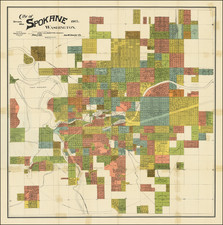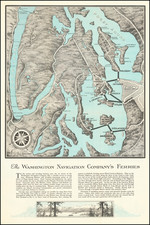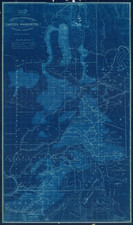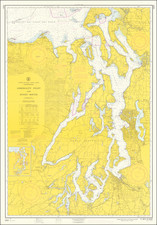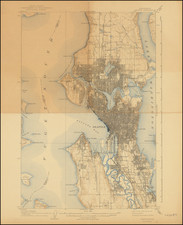1970s reproduction by Seattle-based Kroll Map Company of the famous Augustus Koch bird's-eye view of Seattle.
Seattle is shown as seen from the Southwest, centered on the Capitol Hill and Volunteer Park area, with Lake Washington, Mercer Island, Kirkland, Union Bay, Green Lake, and Ballard on the Horizon.
The view notes that it was issued "Eighteen Months after the Great Fire," of June 6, 1889, which destroyed virtually all of Seattle's wharves and over 30 square blocks of the city. The Key below the map locates approximately 130 points of interest.
The view provides a fine depiction of the waterfront commerce of Seattle, which is concentrated around Elliott Bay.
Augustus Koch (1840-?) was one of the most prolific American engravers of Birds Eye Views working outside of the major publishing centers. Koch initially served in the Union Army during the Civil War as a clerk and draughtsman in the Engineers Office in St. Louis. Although his English was poor, he was later commissioned as an officer and assigned to one of the Black regiments serving in Mississippi where he drew maps for the advancing Union forces. By 1865 he is thought to have contracted malaria and at 25, was discharged from the army.
By 1868, Koch had become an itinerant Bird's Eye View engraver. His earliest dated views are of Cedar Falls, Vinton, and Waterloo, Iowa. At that point his career seemed to take off and in rapid succession, maps by Koch were produced in every section of the country. In 1870 he produced 5 maps in Utah, Wyoming and California. In all, Koch produced over 100 views, including over 20 Texas Views, during a career of 30 years. His last recorded view was produced in Montana in 1898.
Reps notes that while Koch engraved fewer views than some of his contemporaries, "no American viewmaker traveled more widely in search of subjects. . . "











![[ Mt. St. Helens Hazard Analysis Archive - Including Volcanic Ash ] Mount St. Helens Diary: A Sunday Holocaust](https://storage.googleapis.com/raremaps/img/small/72403.jpg)
